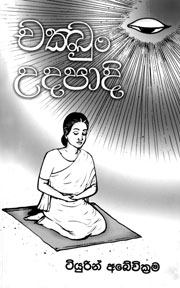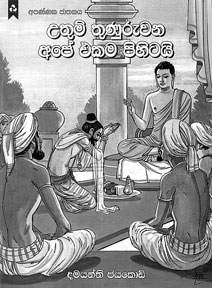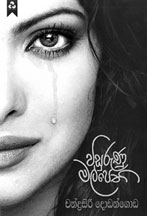|

‘The Shadow’ shows up
Reviewed by Kalakeerthi Edwin Ariyadasa
“The Shadow”, the English version of Siri Gunasinghe’s Sinhala novel
“Hevanella”, appears pat at the centre of two Golden Jubilees. Siri
Gunasinghe and Hemamali celebrate the fiftieth anniversary of their
wedding this year.
 |
|
Sri Gunasinghe |
Incidentally, it is fifty years ago, that Sri Gunasinghe’s
“Hevanella” appeared initially. In a way, as an avuncular gift,
presented at this twin golden jubilee, publisher Vijitha Yapa has
brought out “The Shadow”, in an eye-pleasing format. The English
version, substantially enhances, the impact of the original work at
several levels.
In her foreword, Hemamali Gunasinghe - The translator - traces the
prolonged process that had to be arduously traversed, to approach the
ideal, she entertained, for the perfect incarnation of this work in
English. Even after “The Shadow” entered the public domain, she
confesses her unconcealed regret, in her Foreword:” I traded my dream of
perfecting the manuscript, for reality of having it published soon.
The year 2010 would be the golden anniversary of “Hevanella”. As the
translator recounts it, her sustained translation - exercise, is, a
minor odyssey - in spirit.
While grippingly and sensitively detailing the challenges she
encountered in the course of her translation, Hemamali Gunasinghe,
provides telling insights into the work, in her own critique of the
novel. Her observation of a “Translation” as a “cross - linguistic and
cross - cultural discourse”, will be of considerable practical use to
those who take up this genre.
Prof. K.N..O. Dharmadasa’s assessment of “Hevanella”, placing it in
the historical context of modern Sinhala literature, elevates the
current work, into the upper reaches of contemporary Sinhala literature.
Adding Prof. K.N.O. Dharmadasa’s essay to “The Shadow”, as prefatory
material, is an inspired stroke. In his note, Prof. K.N..O. Dharmadasa,
profiles a series of views articulated by several important critics,
when “Hevanella” originally appeared in 1960.
 Prof. K.N.O. Dharmadasa’s introductory statements, depict the
revolutionary role played by Siri Gunasinghe in the context of Sri
Lankan literature, during the formative years of the Peradeniya school. Prof. K.N.O. Dharmadasa’s introductory statements, depict the
revolutionary role played by Siri Gunasinghe in the context of Sri
Lankan literature, during the formative years of the Peradeniya school.
The material that precedes the text of “The Shadow”, in effect,
prepares the reader for the experience, that awaits him when he begins
to read the novel.
It is essential to note, with stark clarity, that the novel is set in
a cultural milieu that dominated the seats of higher education in the
fifties and the sixties.
Siri Gunasinghe’s protagonist, in “The Shadow”, is, to my mind, a
composite character, with impressive creativity Siri Gunasinghe
“invented” a character, out of a whole series of generic personalities,
to monument and symbolise the mind-set of a whole generation of young
people, who lost their inherited traditional moorings when they were
confronted with an urban and cosmopolitan culture, they could not
adequately come to terms with.
Although “Jinadasa”, is a specific individual, he is the fictional
image of tens of thousands of such young bewildered refugees, washed
ashore in the city, uprooted from the terra firma of familiar rural
settings.
In Jinadasa’s day, the cultural, and even physical lines, that
demarcated the landscape and separated the village from the city, were
distinctly visible.
The sprawling urbanization, that erased the rural identity even of
remote villages, was a symbol of the cultural diffusion, that set in, at
the end of the 70’s. But, prior to the emergence of this phenomenon, the
sensitive young people in the villages, experienced a cultural
self-sufficiency. Though it only may have had dreams about distant
cities, but, for the time being at least, the life in the village,
seemed totally protective.
Jinadasa in his village, was a firmly established soul and was
“certain of certain certainties”. The mother dominated his way of life.
The truths, axioms, philosophies that were needed to buttress his
“little life” in the village, were adequately provided by those rural
leaders he implicitly trusted.
His psychological crisis was that he could not discover any values,
that could replace those he esteemed in the village and were practically
interpreted by his mother.
The norms of life, were indelibly etched deep in the recesses of his
soul. He dreaded to think what disastrous outcome would befall, if he
went counter to those tenets that were driven home deep into his psyche.
Siri Gunasinghe’s portrait of Jinadasa’s character, displays
exceptional fictional dexterity.
Even fifty years after he constructed the personality of Jinadasa,
Siri Gunasinghe’s creation has the potentiality to command absorbed
attention.
Jinadasa is a phenomenon of cultural transition.
He uninhibitedly loathes the characters and the style of life, that
go counter to what he upheld as the ideals, back in his home village.
But, he has a grudging admiration for those who represent the
iconoclasts, symbolised by worldly - wise Wijepala.
At the time, Siri Gunasinghe originally wrote this book in Sinhala,
he too may have appeared an iconoclast. But, a slew of other writers,
adopted the trend.
Siri Gunasinghe was a revolutionary because he articulated matters
that were deemed taboo. But, in yet another sense, he was radical.
He pointedd an escape to a generation of young people, who were
bewildered between two worlds. Siri Gunasinghe, titles this work as “The
Shadow”.
The implication of this image of the shadow, to my mind is
domination.
For so long, he has been in the big and small shadows of others. But,
now he discovers, that he too can cast a massive shadow of his own.
Siri Gunasinghe’s explorations of the mind of a generation, may not
have that compelling power, it would have had half-a-century ago. But,
today too “The Shadow” has its place, as in our day too, the younger
generation is probing to discover certain certainties that would provide
a stability to their inner being.
Tales of marital misery
Reviewed by Padma Edirisinghe

Antho jata bahi jata
Jataya jatitha paja
Thang Thang Gothama puchchami
King umang vijataye jatang
Conflicts within; conflicts without — (the world) is one whole world
of conflicts. The statement attributed to the Buddha is now elongated
into this popular stanza. Does it need evidence? No. The evidence just
glares at you from all directions of the world. If that is not enough
read Turin Abeywickrema’s maiden book. It is one hot house of conflict,
marital conflict to be more specific.
Right from the beginning it’s a morass or tangle of domestic issues.
Really as one reads the various dilemmas the different couples in the
novel are subject to one begins to wonder whether the institution of
marriage is that weak in Sri Lanka. Couples separate after a few months
or years of marriage leaving children helpless. Gossip gets rife and
makes things more smelly. Buddhist stanzas that intersperse the
narrative are one redeeming feature of the book. It transpires the wide
canvas of the Dhamma that stanzas can be drawn from it to bring home a
myriad truth. It shows the wide acquaintance of the author with the
Buddha Dhamma, another praiseworthy factor.
Just picking up more positive factors, Turin Abeywickrema has put out
this book in her retirement that others could well emulate. She has
turned author publisher which may not be a practically wise step,
especially as procedures as marketing become cumbersome for women in our
society.
But let us tackle the book itself and its tale, or many tales. The
scenes shift from one conjugal mess to another, sometimes confusing the
reader.
Is it Soma and Kithsiri squabbling in their bedroom or Leelaratne and
Vajira? Or some other couple? The wife is usually portrayed as the
victim of the lascivious activities of the male with children following.
The psychological analysis of what has led to the estrangement is
inadequate and almost gets swept under the bed by details that crowd the
quarrelling scenes.
The author is a female and in Eastern society this has implications.
One is that female writings are usually considered autobiographical in
that the female world is restricted.
There are limitations to enter into the characters of other women
springing out of this factor. But over the years this line of thought
has weakened.
In fact the author being a stranger to me as I read on the litany of
faithless acts by husbands I could not help wondering whether she was
revealing episodes from her own life. But reading the foreword I
gathered that she was a female leading a happy normal married life.
Then what has caused the obsession? Perhaps the happenings in her
immediate society which seems to proliferate with Gone - astray
characters.
The mother—daughter characters Asokamala and Upuli present the most
despicable of them, working together in the same brothel to satisfy
men’s carnal desires.
But the Buddhist stanzas come in plenty like balm to the eyes and
mind. They provide solace to Soma, who seems to be the main character as
she clings onto the Dhamma to get away from the frustrations of her life
due to an insensitive husband.
Dhammasadang naththi—Ethang pivatha bhikave - There is no healer
equivalent to Dhamma. So, bhikkus, absorb it into you”. Quote Chakkung
Udapadi.
Dostoyevskaya - A suicide Mecca
by Padma EDIRISINGHE
No. Dostoyevskaya is not a Russian female, nor a Russian city. It is
just a station. No. I have not been there. But I read about it and after
reading about it began to wonder whether the great country of Russia is
promoting suicide.
“About 80 people commit suicide on the Moscow Metro every year”, it
reads. Then it goes on, this new station is decorated with brooding grey
and black mosaics portraying violent scenes from Dostoevsky’s famous
novels”. Probably it is his hometown. The main mural is from a scene in
“Crime and Punishment”, while another prominent mural shows a
suicide-obsessed character in the Demons holding a pistol to his temple.
 Russian psychologists are naturally worried. They see the station as
a suicide Mecca, the negative energy released by the murals encouraging
suicide. According to the feature article the station is in itself new.
It was opened only last month. What made the Russian railway build a
whole station to encourage suicide? Is it a device to arrest population
increase? Russian psychologists are naturally worried. They see the station as
a suicide Mecca, the negative energy released by the murals encouraging
suicide. According to the feature article the station is in itself new.
It was opened only last month. What made the Russian railway build a
whole station to encourage suicide? Is it a device to arrest population
increase?
A giant depressed looking figure of the famous 19th century author
himself stares from the murals, as if beckoning would be suicides. Many
experts have warned that if any Russian wishes to die under a train, he
or she would definitely choose this station. The artist of the murals
Ivan Nikolayev has been much criticised for his handiwork, and has
retorted, “What did you want? Scenes of dancing?” No. He says the famous
author does not have them in his books.
In fact Dostoevsky who suffered from depression and a gambling
addiction had been fascinated by the existential question of life, death
and religion and is famed for his characters’ tortuous battles with
inner demons.
Small station Kotagala
Back from a Metro station in Moscow to Sri Lanka, I come specifically
to a small station named Kotagala in the deep highlands. It is famous
for its tunnel, some say the longest. I served at Kotagala for
one-and-a-half years’ no, not at the station but in an educational
institute battling with or stopping battles between Sinhala and Tamil
teacher trainees that were flaring up on the slightest of provocations.
Humans despite all the preachings by great religious leaders seem
always inclined to pick a fight. For mental relaxation or respite from
the job chores, I used to visit the small town in the evenings where I
spotted an unusual person loitering around the station.
On inquiry I was informed that he is an Italian whose family had come
over here, years ago. The rest had gone back, except the Italian who had
taken on the post of the caretaker of the tunnel. I managed to corner
him with the help of the college van driver.
Well, like Dostoevsky he dealt with death. That is why the article on
Dostoyevskaya immediately brought back memories of him. He chuckled as
he talked on the multitude of corpses he had carried away from the
tunnel. Was it too a suicide Mecca even minus macabre drawings on the
tunnel walls? The Italian gave a few reasons for the deaths inside it.
One was its length. The other that it served as a short cut to many foot
trekkers who would have to walk circuitous miles to their abodes’ were
they not to take the short cut of the track ultimately serving a short
cut to death, too.
Night trains are plenty and those who walk far into the night are
usually beset with some domestic or public issue making them heedless of
the oncoming iron monsters rushing in emitting eerie ‘hoos’. The third
was the gloomy and brooding environment created.
Most suicides were in the night and mostly by lovelorn couples. It is
pitch black inside except where a few light posts are and bats like
capsules of oncoming death reinforce the gloom of the scene. Winging to
and fro they keep on thudding on the tunnel walls inviting would be
suiciders.
The long bearded and aged Italian chuckles, “How many lads and lasses
locked first in love and then in death have I carried out in my hands!
Not that I enjoyed it. But what else can I do but laugh at their folly
of ending their precious lives”.
The whole world
He is probably unaware of the inner demons that incite tortuous
battles and are focused on in Dosteovsky’s Demons. They exist not only
in Russia but all over the world including the terrain of Kotagala of
our Central highlands, so beautiful as far as nature is concerned. Only
the human mind has turned destructive and suicidal.And as I revive
memories of that caretaker of the Kotagala tunnel, I wonder whether in
his own way he too like Dostovesky was fascinated by the existentialist
questions of life, death and religion as he dragged lifeless bodies out
of that cavern.
Could be. In fact while elaborating on the queer movements of bats
(an ubiquitous species spelling doom and dismay according to many a
country belief) the caretaker made mention of the fact that just after
the long man made contrivances (hideous again) especially the Raa
Badullas (Night Badulla expresses) powered their way through the tunnel
these black winged ones indulge in a dance of death.
As though whipped into a murderous frenzy they would flit here and
there mingling with the shadows and then beat themselves against the
tunnel walls and willfully succumb to instantaneous death.
Bats die in 100s
“They die there in hundreds but just keep on multiplying later. It is
so strange”, he said.
“Just like humans” I ventured my own mild philosophy. In response to
his quizzical look I had to elaborate on the point. Humans too are
subject to all kinds of deaths.
Some die of natural causes, while yet others die of battles, of bomb
attacks, of mine slides and mudslides and volcano eruptions of grisly
train and boat accidents, of suicidal tendencies and what not.
But that does not prevent more and more fattening the flock everyday
worldwide in thousands and thousands, even millions.
That is so, he condescends to agree stroking his beard matted with
black and white and ash hued streaks. His face reflects a tortuous life
spent inside a fiercely dark tunnel sharing the day and night mostly
with bats and corpses.
He keeps on stroking his beard thoughtfully and maybe it is my
wretched imagination that makes me spot on his fingers a horrid mixture
of bat excreta and red blood gushing out of mothers’ wombs at delivery.
 [Book launch] [Book launch]
Unpublished Letters of Ananda Maitreya Maha Nayake Thera
Samudra Wettasinghe’s “Unpublished Letters of Ananda Maitreya Maha
Nayaka Thera” will be launched at the Sri Lanka Foundation Institute
auditorium, Independence Square, Colombo 7 on July 22 at 3 p.m.
The launching ceremony will be presided over by Ven. Prof. Bellanwila
Wimalarathana, Chancellor, Sri Jayewardenepura University.
Nagaviharadhipathi Ven. Maduluwawe Sobhitha Nayake Thera and Ven.
Karagoda Uyangoda Maithreemoorthy Mahanayake Thera will deliver the
commemoration talks.
 Uthum Thunuruvana Ape Ekama Pihitai Uthum Thunuruvana Ape Ekama Pihitai
Damayanthi Jayakody’s Buddhist book entitled “Uthum Thunuruvana Ape
Ekama Pihitai” (latest edition) will be launched at the Dayawansa
Jayakody Book Exhibition Hall, Ven. S. Mahinda Mawatha, Colombo 10 on
July 20 at 10 a.m.
Uthum Thunuruvana Ape Ekama Pihitai is a Dayawansa Jayakody
publication.
 Visirunu Malpethi Visirunu Malpethi
Chandrasiri Dodangoda’s “Visirunu Malpethi” (latest edition) will be
launched at the Dayawansa Jayakody Book Exhibition Hall, Ven. S. Mahinda
Mawatha, Colombo 10 on July 27 at 10 a.m.
The author has written several other novels such as “Sathi”
Pujasanaya, Kandulu Dorakada, Sanda Kaluvarai, Lochana, Dedenek Saha
Katha Dekak. Some of the novels were made into teledramas.
Visirunu Malpethi is a Dayawansa Jayakody publication. |

